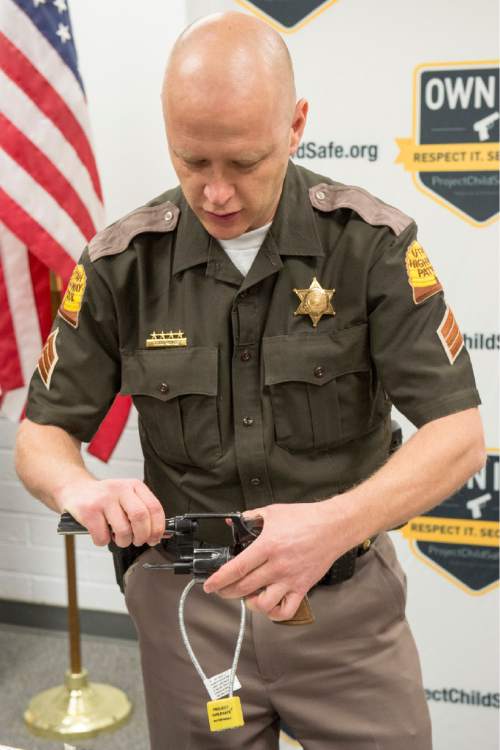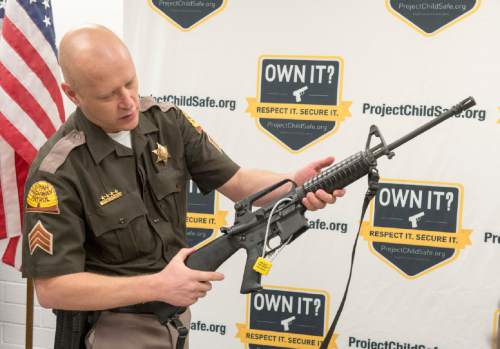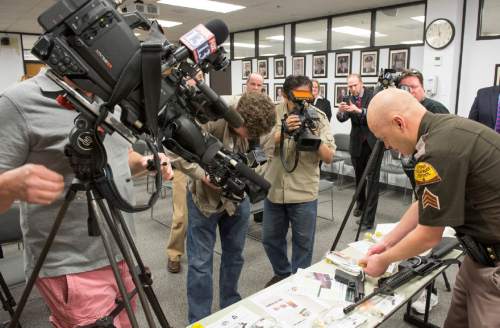This is an archived article that was published on sltrib.com in 2015, and information in the article may be outdated. It is provided only for personal research purposes and may not be reprinted.
Taylorsville • As experts looked into news cameras and urged the public to secure its guns, Jeff Carr stood in the back of the room, remembering the scenes of suicides to which he's had to respond.
With more than 30 years as a police officer, Carr can recall half a dozen such cases seared into his memory. Now that he's the Utah Department of Public Safety's deputy commissioner, he wants to support any avenue to prevent them — including a new awareness campaign to encourage gun owners to lock up their firearms.
"Anything we can do to prevent even one suicide, we want to do that," Carr said Thursday, during the kickoff of the Project Child Safe campaign.
The initiative will distribute safety pamphlets to parents during school seminars, as well as 40,000 free cable locks through law enforcement agencies, emergency rooms and firearm-safety classes. The locks run a cable through the mechanism of an empty gun so that it can't be loaded. They were purchased from the National Shooting Sports Foundation, thanks to funding from a Utah bill passed last year.
Rep. Steve Eliason, R-Sandy, sponsored HB134, which also calls for schools to notify parents of bullying or suicide threats. Utah ranks fifth in the nation for suicides among children ages 10 to 17, per capita, said Eliason, who described the problem as a "public health epidemic."
Guns are the most common method used to commit suicide, and Eliason is wary of the disconnect between parents — who insist their guns are secured — and their children, who say they know how to access them.
"Most parents don't know that 85 percent of young people, nationally, that die by firearm suicide do it with a parent's gun," Eliason said. "It's a terribly sobering statistic."
Eliason acknowledged that a common question arises: Wouldn't people who want to commit suicide just choose another means in the absence of a gun?
"The answer is: Many do, but you're much more likely to survive if they use another method," he said, adding that about 90 percent of people who survive a suicide attempt never end up taking their own lives.
After handing out more than 15 million locks since 1998, NSSF President and CEO Steve Sanetti is unaware of a single instance of a child breaking one of its locks and using a gun.
He hopes that the campaign will remind gun owners that they have to respect what the weapon can do, and secure it when it's not in use. Simply hiding guns and expecting children not to find them, he said, is not safe.
Sanetti also encourages gun owners to store firearms unloaded, and to keep ammunition locked up in a separate location.
Utah's suicide rate has been consistently higher than the national average for the past decade. That places the state in the middle of the so-called "suicide belt," a north-to-south column of states from Arizona to Montana where suicides are among the highest in the country. And more than half those deaths are by firearm, said Doug Thomas, director of the Utah Division of Substance Abuse and Mental Health.
"It's important to note that suicide is largely preventable," Thomas said. "... [And] hope does come back into people's lives. Many times it feels hopeless, and the pain feels like it's not going to end. But there is hope, there is support, there are people and resources available to help."
The Suicide Prevention Lifeline is available at 1-800-273-8255, as is the Utah Neuropsychiatric Institute's CrisisLine at 801-587-3000. The Utah Suicide Prevention Coalition also provides a list of other local resources on its website, at utahsuicideprevention.org/crisis-services.
Eliason shared the story of a man who jumped from the Golden Gate Bridge in San Francisco. As soon as the man leapt from the bridge, Eliason said, he realized that the only thing in his life he couldn't fix was the fact that he had just jumped.
Twitter: @mikeypanda

























